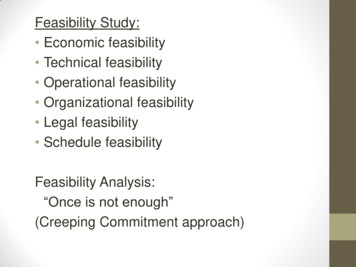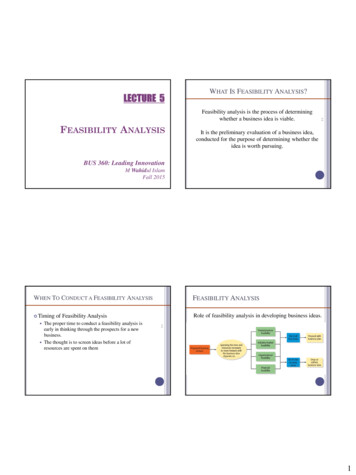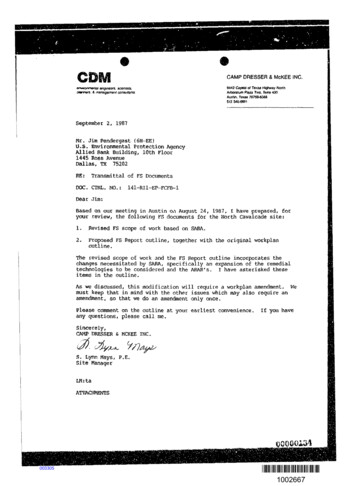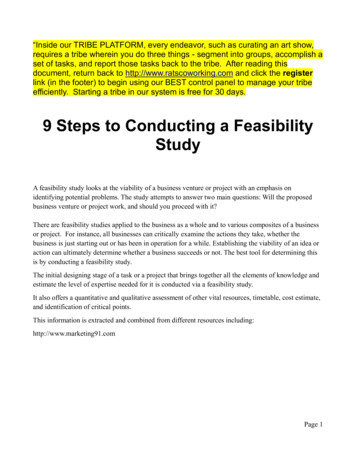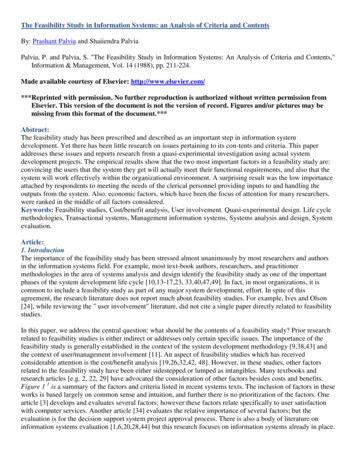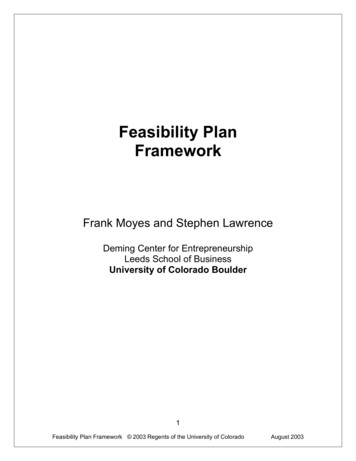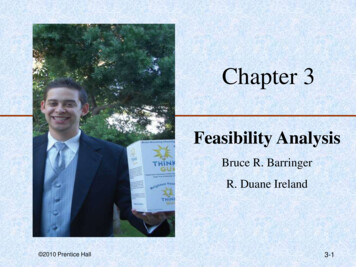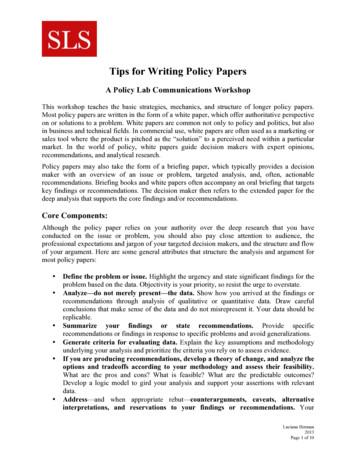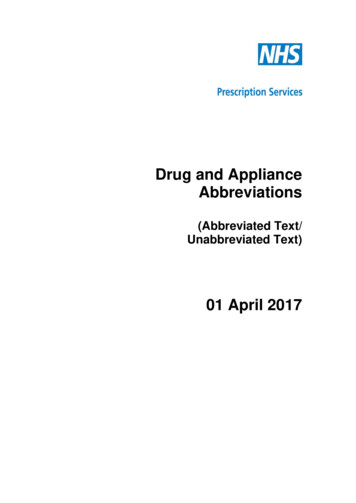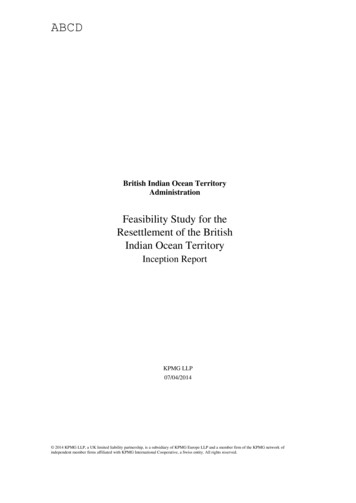
Transcription
ABCDBritish Indian Ocean TerritoryAdministrationFeasibility Study for theResettlement of the BritishIndian Ocean TerritoryInception ReportKPMG LLP07/04/2014 2014 KPMG LLP, a UK limited liability partnership, is a subsidiary of KPMG Europe LLP and a member firm of the KPMG network ofindependent member firms affiliated with KPMG International Cooperative, a Swiss entity. All rights reserved.
ABCDBritish Indian Ocean Territory AdministrationFeasibility Study for the Resettlement of the British Indian Ocean TerritoryKPMG LLP07/04/2014Contents1Introduction11.1Overview of the feasibility study11.2Structure of this inception report12Key principles for the study22.1A neutral analysis22.2Open consultation22.3The importance of the environment and an integrated approach22.4Resettlement options32.5Presenting findings in a clear and accessible way43Approach to the study53.1Key phases of activity53.2Analytical framework83.3Core study team12Annex A: Terms of reference14Annex B: List of documents20
ABCDBritish Indian Ocean Territory AdministrationFeasibility Study for the Resettlement of the British Indian Ocean TerritoryKPMG LLP07/04/20141Introduction1.1Overview of the feasibility studyIn March 2014, the British Indian Ocean Territory (BIOT) Administration commissionedKPMG to carry out a feasibility study for the resettlement of BIOT. The feasibility studywill be undertaken over a ten-month period between April 2014 and January 2015. It willbe conducted by a multi-disciplinary team, who together will prepare a neutral analysis ofdifferent options for the resettlement of BIOT. These options will be differentiated by anumber of factors, including the likely location, scale and type of possible resettlement.For each option, the feasibility study will consider the following: the likely cost to the UK Government of establishing and maintaining a settlementover periods of five, ten and twenty years; whether such a settlement could be economically self-sustaining and, if so, withinwhat time period and under what conditions; and the associated risks and full costs of mitigation, in the event that resettlement takesplace.The outcome of the study will be the identification of the most feasible options for theresettlement of BIOT. This will in turn enable Ministers to take an informed policydecision on the resettlement process. Detailed terms of reference for the study areincluded in Annex A.1.2Structure of this inception reportThis inception report is the first milestone of the feasibility study‟s four-week inceptionphase, which started on Wednesday 5th March. The report collates the work of the studyteam to date, and includes: an overview of the key principles which will guide the study; a summary of the resettlement options which the study will consider; a description of the key phases of the study and the analytical framework throughwhich the potential costs, environmental impacts and benefits of each resettlementoption will be assessed.1
ABCDBritish Indian Ocean Territory AdministrationFeasibility Study for the Resettlement of the British Indian Ocean TerritoryKPMG LLP07/04/20142Key principles for the studyThe approach adopted by the feasibility study team will be guided by the followingoverarching principles.2.1A neutral analysisThe team will seek, with the support of the BIOT Administration, to obtain as muchinformation as possible about the background to the potential resettlement of the BIOT.This will include the earlier feasibility study, all related peer reviews, independent studieson resettlement and the documentation gathered as part of the initial stakeholderconsultations that took place in 2013. This will enable the team to establish a clear pictureof the context in which the study is taking place. The team will, however, adopt a‘neutral’ approach, starting afresh when analysing the expected costs, environmentalimpacts and benefits of each resettlement option without being steered by the conclusionsof others. A full list of the documents collected by the team to date is presented in AnnexB. It is expected that this list will expand as the main phase of the study progresses.2.2Open consultationThe process of consultation which began in 2013 will continue through the main phase ofthe study, and the team will run a number of structured consultation events, both in theUK, Mauritius and the Seychelles which will be organised by the BIOT Administrationwith support from the British High Commissions in these countries and facilitated byChagossian community leaders. In addition, views will continue to be requested by e-mailthroughout the process. Views will be sought from Chagossians as well as the scientificcommunity (e.g. Chagos Conservation Trust, Pew) and others with an interest in the issueof resettlement. Governments (including representatives from Mauritius, the Seychellesand the US) will be kept informed. These will be important as a means to verify andconfirm the findings of the team‟s desk research and interviews. Hence, human andscientific considerations will be important in the process and inform our evaluations.Two rounds of such consultations are envisaged in June and October: the first with afocus on gathering information and further development of resettlement options, thesecond with a focus on reconfirming, cross-checking and verifying the team‟s initialresults – as well as on enabling the team to gain early feedback on the provisionalfindings of the study.Monthly update reports will be shared by the BIOT Administration.2.3The importance of the environment and an integrated approachThe continued physical and socioeconomic existence of BIOT depends on the health ofits underlying coral reefs, upon which the islands are delicately perched. A high level ofinterdependence calls for joined-up thinking about BIOT‟s coral islands and about therisks, environmental impacts and benefits associated with alternative re-settlementoptions. This will be an overarching thread in KPMG‟s evaluation.2
ABCDBritish Indian Ocean Territory AdministrationFeasibility Study for the Resettlement of the British Indian Ocean TerritoryKPMG LLP07/04/20142.4Resettlement optionsThe feasibility study will be focused on the following three options, each of which will beanalysed against the baseline status quo: Option 1: Small-scale resettlement. This scenario envisages a limited population ofresettlers, whose livelihoods could be supported in a number of ways. This mightinclude, for example, the management of the Marine Protected Area, activities such asartisanal fishing, or employment on the US military facility on Diego Garcia. Option 2: Large-scale resettlement. This assumes a more substantial settlement,with economic opportunities built around activities such as tourism and/or commercialfisheries. This form of resettlement would require infrastructure development on theouter islands of the archipelago, in order to provide adequate support services for thereturning population (including, for example, education and health facilities). Option 3: Limited stay or seasonal returns. This scenario serves as a middle groundbetween permanent substantial resettlement and the status quo. It would require somelimited investment in infrastructure and facilities, in order to enable interestedChagossians to return to the islands for occasional visits, but not to resettle on apermanent basis.The analysis of these options will consider the possible location of any futureresettlement, including both Diego Garcia and the outer islands. The latter will includethose formerly inhabited by Chagossians: Salomon atoll (Ile Boddam), Peros Banhos atoll(Ile de Coin and Ile Diamont), Egmont atoll (Ile Sudest) and Great Chagos Bank (Eagleisland). The analysis will also proceed on the understanding that these options are notmutually exclusive and that there is scope for a phased approach to the resettlementprocess.The analysis of these options will be grounded in an assessment of the likely number,profile and expectations of returnees, as well as an environmental evaluation of differentre-settlement scenarios. The study team will seek to quantify and understand the demandfor resettlement, including the following: approximately how many Chagossians want to return (including the number andtypical family sizes); the profile of those who want to resettle (considering, for example, their age, skills andtraining and financial resources); and lifestyle expectations.This analysis will enable indicative predictions of the facilities required to support theresettlement process, as well as likely costs and impacts associated with construction ofinfrastructures, Chagossian activities, including transport, and likely mitigation measuresrequired (e.g. against coastal erosion, sea level rise). It will ensure adequate scope forplanning and sustainability, should resettlement take place.3
ABCDBritish Indian Ocean Territory AdministrationFeasibility Study for the Resettlement of the British Indian Ocean TerritoryKPMG LLP07/04/20142.5Presenting findings in a clear and accessible wayThe final output of this feasibility study will be a report that sets out an economic and,financial and environmental analysis of each resettlement option, to reflect the likelyimplications for the BIOT over the short, medium and long term including ongoingliabilities. The report will address in detail the range of issues identified in the analyticalframework presented in section 4.2, and will also be supported by clearly definedestimates of capital costs, operating and maintenance costs and potential revenue streamsfor the BIOT.The study team recognises the importance of ensuring that the final output of this study iseasy for readers to follow, with a logical structure, providing context and presenting thefindings in a clear and concise way. This is particularly critical given the sensitivity ofthis assignment. The report will therefore be presented in draft form providing asignificant period towards the end of the study during which the report can be shared anddebated with the Chagossians, scientific experts and other parties.4
ABCDBritish Indian Ocean Territory AdministrationFeasibility Study for the Resettlement of the British Indian Ocean TerritoryKPMG LLP07/04/20143Approach to the study3.1Key phases of activityPhase I: consultation and data gathering (April – June 2014). The team will begin themain phase of the study, the aim of which will be to consult with the Chagossians andother key stakeholders to gather relevant data on the population, as well as on the carryingcapacity and resources of the islands themselves through a visit to the Territory.Literature searches and consultations with scientists familiar with BIOT will also beimportant.While the team will start with a blank slate, attempts have already been made to surveythe Chagossians, and to establish a clearer picture of the numbers who wish to return. TheHowell Report of 2008 is one such resource, and the team will need to undertake athorough and critical desk-based review of relevant materials and consultation papersbefore beginning its fieldwork. The fieldwork will, nevertheless, be critical, and willinvolve face-to-face consultation events and the use of structured questionnaires to surveythe Chagossians resident in the UK, Seychelles and Mauritius.The aim of this will be to understand, in more in-depth terms: how many people want to return, under what circumstances; the specific nature and likely timing of this return (either permanent or temporary); the profile of those who would consider resettling (covering the issues noted above insection 2.4); and lifestyle expectations, based on current living standards in the Chagossians‟ respectivelocations.The result of this consultation process will be detailed socio-economic profile estimatesfor the average Chagossian family that chooses to resettle, in terms of costs and incomes,and relative to lifestyle expectations and island conditions. The team will model thesecosts and incomes over a 5, 10 and 20-year time-span, to allow for adequate scenarioplanning. The team will also produce a short report recording these consultations whichwill be circulated by the BIOT Administration for information. As noted below, climatechange impacts will be considered over longer time scales (2050 at least), in accordancewith the timeframe used by many agencies including the IPCC.An integral part of this work will be collecting and synthesising key environmentalstudies and works on the British Indian Ocean Territory, so that the direct and indirectenvironmental implications of the different re-settlement options, including anticipatedtransport needs, can be understood as fully as possible. This will allow weighting oflikely economic opportunities against projected financial costs, risks and environmentalconsequences.5
ABCDBritish Indian Ocean Territory AdministrationFeasibility Study for the Resettlement of the British Indian Ocean TerritoryKPMG LLP07/04/2014Phase II: analysis (July-Sept 2014). Having gathered relevant data through deskresearch and consultations, the team will reconfirm, cross-check and verify informationsuch as those wishing to return as well as undertake a detailed analysis of the prospectsfor an economically self-sustaining community on BIOT, weighing the likely economicopportunities against the expected financial and environmental risks and costs We willcarry out a realistic assessment of opportunities for: gainful employment (e.g., in agriculture, fishing, handicrafts, etc); tourism (possibly requiring private sector involvement) in fields such as eco-tourism,the development of a small exclusive resort (cf. Maldives), cruise-ship visits, researchand scientific visits; BIOT government employment; income generation opportunities through the BIOT; and the possibility of remittances and/or contributions from other sources (both public andprivate).Alongside this we will calculate the likely financial costs and environmentalconsideration of resettlement, covering: access facilities; housing; transportation requirements (includinginternational, inter-island and terrestrialtransportation); schools and clinics; power generation; administration buildings; telecommunications; and water, sanitation and waste facilities.Besides the capital costs of the above items, the team will also consider the question ofoperating costs, payment for services, as well as administration (e.g. any need for anexpatriate doctor, teacher, etc.).Phase III: production of the study report (October 2014 onwards). The result of thiswork will be presented initially in a draft feasibility study report, and will set out aneconomic, financial and environmental analysis of each resettlement option. This willreflect the likely financial implications over the short, medium and long term, and will besupported by clearly defined estimates of: capital costs, including any contingent liabilities, especially for the first five years; annual operating and maintenance costs, including Chagossians employed in localgovernment jobs;6
ABCDBritish Indian Ocean Territory AdministrationFeasibility Study for the Resettlement of the British Indian Ocean TerritoryKPMG LLP07/04/2014 revenue and income from the following: payments for utility services; levies ontourists and visitors; import duties and taxes; land sales and fees; rents; other income(e.g. stamps, coins, internet registration, etc.); environmental-financial implications of the resettlement options and transport needs,including costs of upholding BIOT ordinances and international legislation,environmental monitoring and also measures needed to combat sea level rise andcoastal erosion plus estimated costs; presentation of results in the form of a spreadsheet model over 20 years for eachoption, with sensitivity tests on key parameters (these will emerge during the analysis,but could include an increase or decrease in resettlement numbers, success indeveloping local economic initiatives, implementation delays, etc).The draft will be circulated by the BIOT Administration to those with an interest for finalviews before being finalised and published without revision.7
ABCDBritish Indian Ocean Territory AdministrationFeasibility Study for the Resettlement of the British Indian Ocean TerritoryKPMG LLP07/04/20143.2Analytical frameworkThe study team will analyse the different resettlement scenarios, using the framework set out below.Area of analysisKey questions/issues for consideration1. Likely number, profile andexpectations of returnees How many Chagossians want to return to BIOT (either permanently or temporarily), both interms of numbers and family sizes? What is the age and skills profile of those who wish to resettle (this will be important indetermining the facilities, service and service requirements)? What are the lifestyle expectations if resettlement takes place (e.g.: reasonably modern;subsistence; eco village; temporary pilot resettlement; scientific research station)?2. Legal and political factorsWhat are the likely implications of the following: agreements with the US Government, given their military presence on Diego Garcia? the Marine Protected Area, established in April 2010? existing BIOT Ordinances? human rights considerations8
ABCDBritish Indian Ocean Territory AdministrationFeasibility Study for the Resettlement of the British Indian Ocean TerritoryKPMG LLP07/04/2014Area of analysisKey questions/issues for consideration3. Environmental impact ofresettlement options includingtransport needs flora and fauna and the marine reserve; any international agreements; human carrying capacity of the islands; and environmental evaluation of the different resettlement options over 5 years, 10 years, 20 years and possibly longer time periods,integrating the experience/role/involvement of resettled Chagossians in protection ofmarine/land environment; sea level rise, other climate change impacts and „natural‟ processes (e.g. erosion), includingpossible mitigation costs up to 2050 at least.4. Economic prospectsWhat are the opportunities for the following: gainful employment (e.g., in agriculture, fishing, handicrafts; etc.)? tourism (possibly requiring private sector involvement) in: eco-tourism, small exclusive resort(cf. Maldives), cruise-ship visits, research and scientific visits? The dynamic between economicviability and ecological sustainability will be particularly important. BIOT government employment? income generation opportunities through BIOT government (e.g. stamps, coins, internetregistration, etc.)? the possibility of remittances and/or contributions from other sources (both public and private)?9
ABCDBritish Indian Ocean Territory AdministrationFeasibility Study for the Resettlement of the British Indian Ocean TerritoryKPMG LLP07/04/2014Area of analysisKey questions/issues for consideration5. Access issuesThis could be a major consideration, given the experience of others (including Overseas Territoriessuch as Pitcairn, as well as the Seychelles and Rodrigues), so there is a need to consider optionssuch as: docking facilities, an airstrip; access through American facility (cf. Ascension); and/or shipping facilities.6. Training and administrationrequirementsThe former would, in particular, require an assessment of the skill sets that potential resettlers wouldbring.7. Risks and uncertainties There is likely to be a need for a comprehensive statement of the risks and uncertaintiesassociated with the resettlement process. This would include the identification of potentialmitigation measures, if any are required. This may, for example, involve a disastermanagement plan in case of extreme emergency (e.g. dramatic climate change, tsunami,etc.), which may draw on the regional experience of disaster management plans (cyclones,climate change, and recent tsunami alert and management system); The limits of acceptable environmental change need to be addressed and agreed prior to any resettlement; and, if limits/thresholds are crossed (e.g. unacceptable nutrient levels from sewage orfall in coral biodiversity), consideration needs to be given to the practical and financialconsequences – again before any new infrastructures associated with re-settlement are built.10
ABCDBritish Indian Ocean Territory AdministrationFeasibility Study for the Resettlement of the British Indian Ocean TerritoryKPMG LLP07/04/2014Area of analysisKey questions/issues for consideration8. Benchmarking with other islandsThis would identify and draw comparisons to (i) other Overseas Territories (e.g. Pitcairn, St Helena,Ascension (which also has an American facility), Montserrat, Tristan da Cunha, etc.; (ii) otherislands with similar issues/problems around the world related to: USA, France, Australia, involvingbases, mineral development or which face similar environmental problems (e.g. Maldives), andsuch issues.11
ABCDBritish Indian Ocean Territory AdministrationFeasibility Study for the Resettlement of the British Indian Ocean TerritoryKPMG LLP07/04/20143.3Core study teamThe study will be lead by a small core team, as described in the paragraphs below.Malcolm Summerfield, Economist. Malcolm brings 40 years‟ experience working oneconomic planning, development and feasibility studies across the Caribbean, Africa,Asia, Middle East, Eastern and Central Europe, Europe, Central and South America. He isexperienced in a wide range of projects, with an emphasis on economic and financialevaluation, institutional development, national and regional analysis, market analysis,water resource planning, water supply and sewerage projects, environmental studies,transportation studies, energy projects, mining projects and other types of infrastructure.Malcolm has been closely involved in a full range of economic and financial assignmentsin the Overseas Territories for the last eight years, in Anguilla, Montserrat, Pitcairn, StHelena and Tristan da Cunha. Malcolm will be responsible for the economic aspects ofthe feasibility study, analysing the likely cost implications and economic opportunitieslinked to resettlement.Professor Andrew Price, Environmental Specialist. Andrew is a marine biologist,environmental advisor, consultant and writer. He has specialist knowledge of the Gulf,Middle East and the wider Indian Ocean region. His main work is on biodiversity,resilience, environmental disturbance and compensation, conservation and protectedareas. He also has extensive experience in integrated planning. For his evaluation ofcoastal damage from the 1991 Gulf War, Andrew received the British Consultant of theYear Award, a prize open to entries from industry and academia. He is currently a visitingprofessor at Warwick University and honorary professor at York University. Andrew hasvisited the Chagos Archipelago three times, and published seven papers on theenvironment, biology and natural resources, as well as being a co-author of theconservation management plan for Chagos. Andrew will lead on the environmentalaspects of the feasibility study, exploring the likely impact of resettlement on theenvironment.Nancy Laatunen, Resettlement and Social Development Specialist. Nancy bringsmore than three decades experience in international development, with track record in 46countries. She resided in Africa for eight years and has completed over 75 assignmentsfor the World Bank, Millennium Challenge Corporation, Asian Development Bank, InterAmerican Development Bank, CIDA, and UNDP. Nancy brings a strong track record inresettlement planning, gender equality, community development and social developmentimpact assessments. Most recently, Nancy has acted as a Resettlement and SocialSafeguards Specialist for the Asian Development Bank, analysing the possible impact oftransport projects along the Greater Mekong Subregion East-West Economic Corridor.She served as team leader and socio-economist for an impact assessment of a World BankRoad Maintenance and Rehabilitation Project in Papua New Guinea. Nancy directed a 14person team, training team members on social and environment data collection in 24villages to measure impacts on villagers' lives. This project was subsequently showcasedat the International PIARC Conference in Paris for its excellent work in poverty results.Nancy will consider the social factors related to the proposed resettlement process, andwill lead on the design of consultations with the Chagossians themselves.12
ABCDBritish Indian Ocean Territory AdministrationFeasibility Study for the Resettlement of the British Indian Ocean TerritoryKPMG LLP07/04/2014Matthew Boyle, Project Manager. Matthew will serve as the overall manager of thisfeasibility study, responsible for ensuring a coherent approach, maintaining close liaisonbetween the expert team and key counterparts from the FCO and BIOT. Matthew is a coremember of KPMG‟s International Development practice in the UK, as well as anexperienced programme manager – and brings experience from a wide range of relevantsectors. He currently oversees a complex 5 million DFID-funded Commercial Law andJustice Programme, the aim of which is to encourage justice sector reforms in a range ofcountries in order to foster economic growth. He has assessed the effectiveness andimpact of education and health sector reforms in Malawi and Pakistan. Matthew alsobrings relevant Overseas Territories and island experience, having been a key teammember on a DFID-funded Public Service Reform Programme in Montserrat.Nathan Hill, Project Assistant. The core team will also be supported by Nathan Hill,who works in KPMG‟s London practice alongside Matthew. Nathan has relevant practicalexperience as an economist in the UK Government Economic Service, as part of the civilservice fast-stream graduate programme. He also served for several years on the OverseasDevelopment Institute Fellowship, as an economist and policy adviser working on foodsecurity issues within the Ministry of Agriculture, Forestry and Food Security in SierraLeone. Nathan will provide backstopping support to the team as a whole, and will workalongside Malcolm in the assessment of the likely costs and income streams associatedwith the proposed resettlement options for the BIOT.This core team will be supported by a wider pool of experts, both international andregional, the composition of which will be determined during the inception phase.13
ABCDBritish Indian Ocean Territory AdministrationFeasibility Study for the Resettlement of the British Indian Ocean TerritoryKPMG LLP07/04/2014Annex A: Terms of referenceFor a new Feasibility Study into the resettlement of theBritish Indian Ocean Territory (BIOT)January 2014Foreign & Commonwealth OfficeOBJECTIVE1. To advise on the feasibility of different options for the resettlement of the BritishIndian Ocean Territory (BIOT), estimating their likely costs and risks. To addressall relevant issues, including financial, legal, environmental, logistics, social,economic and defence.THE RECIPIENT2. The BIOT Administration.THE SCOPEWhat is included:3. The Feasibility Study will consider a range of options for the resettlement ofBIOT, differentiated by factors, including: The location, which would include consideration of the outer islands and ofDiego Garcia. The scale of possible resettlement and sustainable socio-economicdevelopment options in the short (5 years), medium (10 years) and long-term(20 years), including livelihood opportunities. The types of possible resettlement drawing on suggestions from the initialconsultation. The environmental carrying capacity of the proposed locations (access towater, energy, sources of food etc). The environmental feasibility will takeinto account likely scenarios of climate change and sea level rise, followinggood practice from the IPCC (Intergovernmental panel on climate change).14
ABCDBritish Indian Ocean Territory AdministrationFeasibility Study for the Resettlement of the British Indian Ocean TerritoryKPMG LLP07/04/2014 Take full account of scientific uncertainty around areas such as climatechange, sea level rise and carrying capacity, including fisheries productivityby expressing ranges and probability instead of a single model as the basis. When considering the options, the Study will address the followingquestions:- What would be the cost to the UK of establishing and maintaining asettlement over 5, 10 and 20 years?- Could a settlement be economically self-sustaining and if so within whattime period and under what conditions? The Study will factor in the suggestions made in the initial consultation onthe review of resettlement of BIOT and propose which specific options willbe considered. The options to be analysed will form part of the InceptionReport. The Study will take account of the suggestions made during theconsultation on the type of resettlement. These suggestions include: a modernlifestyle; a subsistence lifestyle; an eco-village; a pilot resettlement withsome employment on the Diego Garcia military base; a scientific researchstation.What is excluded:4. Proposals or suggestions not directly relating to the feasibility of resettlement areoutside the scope of this study. This includes any issues relating to sovereignty,nationality, and historical compensation payments.5. This work is undertaken without prejudice to any on-going litigation.REQUIREMENTS6. The options should be developed using multi-disciplinary expertise. Drawing onexperts will be essential, inter alia, in the fields of livelihoods and socialdevelopment, economics, defence, industrial development, anthropology, healthcare, education, environment, climate change, science and conservation.7. The Feasibility Study would need to analyse each option, in a neutral way. Itshould include analysis of the factors below, but could use an alternativeframework to the PESTLE one suggested. The framework m
Feasibility Study for the Resettlement of the British Indian Ocean Territory KPMG LLP 07/04/2014 4 2.5 Presenting findings in a clear and accessible way The final output of this feasibility study will be a report that sets out an economic and, financial and environmental analysis of each resettlement option, to reflect the likely
